Well, it's a whole card game and it's the place of person, who has a triumph.
In the Charles VI deck we have the Medici heraldic at this same place, at the chariot.
The Ursino cards changed the chariot, perhaps because this reason. Though, I don't recognize a replacement heraldic, but the photo is bad.
Btw. I detected the sword-king of the Ursino deck in the Hoffmann book, which I earlier had ignored. Interestingly it presents a diamond ring on a shield, combined with an object, that I can't identify and it's difficukt to describe.
The cards belonged to Alessandro Sforza. The diamond ring was used 1475 as symbol for the Hymeneus at the marriage of Costanzo Sforza and Camilla d'Aragon.
Do you have seen pictures of the Ursino cards meanwhile?
Re: Bolognese sequence
72Here are two images -
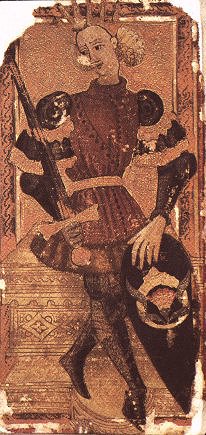
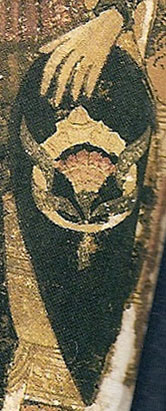
Algeri held, maybe still holds, it to be Borso's sign. More people hold it to be Alessandro Sforza's - I'll have to check who it is.
I found an example -
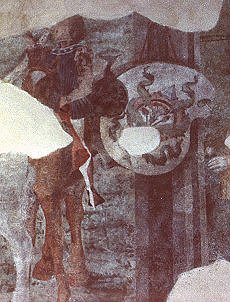
but I don't have the details on hand.
---------------Edited (it was Enrica Domenicali who considers it Borso's - this debate between Algeri and Domenicali happened in 1987) -
Here is what I wrote privately on the subject in August -
"I posted about this image on the Aeclectic forum in February of last year, in case you want to read it there -
http://www.tarotforum.net/showthread.ph ... ge=2&pp=20
Interesting information about it is that one author, dal Pozzolo, says that the manuscript was made in Pesaro, and Trapp says it was made for Borso d'Este (both quoted below):
-------------------------------
The three oldest known handpainted cards depicting the Hermit (for the sake of convenience we'll call him that) show him holding an hourglass.
He is not represented as such in any printed cards that I can recall, the three traditions showing an allegorical figure of Time with wings and crutches (A or Southern), or holding a lantern (B (Ferrara) and C (Tarot de Marseille)). Maybe the hourglass is added somewhere in the picture, but he is not holding it.
The allegory of Time with wings and crutches (showing Time flies, as well as the effects of age) is first attested in the early 1440s, with the earliest dated example being 1442, according to a paper by Simona Cohen, "The early Renaissance personfication of Time and changing concepts of Temporality" (Renaissance Studies vol. 14 no. 3 (2000) pp. 301-328). This personification occurs in manuscript illustrations and cassoni (wedding chest) paintings of Petrarch's Trionfi, and of course in the A or Southern kind of tarot cards.
Cohen says about the hourglass motif -
An important attribute of time, the hourglass, seems to have made its first appearance in the Trionfo del Tempo about 1450. It was then introduced in a whole series of cassone. We have seen that images of the initial stage [of depictions of the Triumph, 1440s], such as the globe and elements, were carried over by medieval cosmic imagery, but the hourglass had no cosmic connotations and was comparatively new to art: the earliest known depiction, used as an attribute of Temperance in the Palazzo Pubblico in Siena, preceded its appearance in the Trionfo del Tempo by about 100 years. Temperance signified moderation, regularity, and restraint, in other words, moral self-discipline or the self-imposition of limits. The hourglass of Temperance showed that proper measurement and utilization of time was a virtue. When in the fifteenth century Time made his debut with an hourglass, Temperance had long ago forsaken hers for a clock. Although there is one example of a mechanical clock on a cassone of the mid-Quattrocento, the fact that illustrators of that period still preferred to represent time by the hourglass, rather than the modern clock that was perfecting time measurement, indicates that these were not interchangeable symbols. The regularity of clockwork had become a simile for the regularity of man's body and spirit when ruled by reason. The hourglass conveyed the idea not of accurate measurement but of the brevity of human life. It was a perfect object to express the sense of value that men attached to the brief time allotted them. Concurrent with the appearance of the hourglass in Italian art, there was new emphasis on a more practical approach to time in religious and secular literature. (pp. 311-313; bold emphasis added)
The two emphases in the quote above would seem to support, first, the idea that we cannot date the Charles VI and Catania packs earlier than 1450; second, it reinforces what we know about Dominican and Franciscan preaching about the sins of playing games, which in the 1440s and 1450s was listing them starting with "Amissio temporis" - wasting time.
Cohen provides many examples of the Triumph of Time, but one she shows is the closest cognate image I have seen to the earliest tarot images -
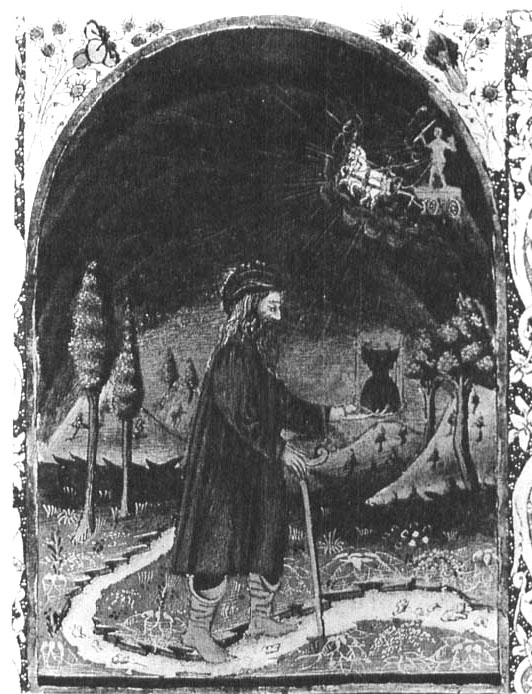
Cohen simply describes the image as "North Italian illumination, 1459", with its location in the Österriechische Nationalbibliothek, Vind. 2649, fol. 46r.
Comparing it to the set of related tarot cards:
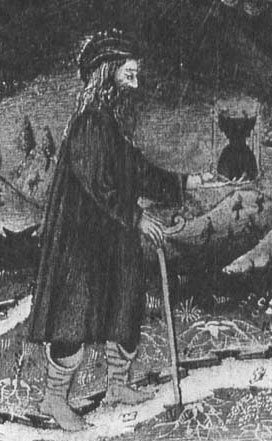
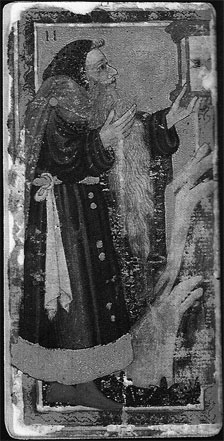
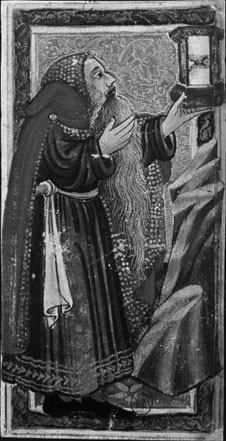
I couldn't find a better image of the manuscript, but another author made an allusion to the work and gave some other details. Enrico Maria dal Pozzolo, "Laura tra Polia e Berenice di Lorenzo Lotto" (Artibus et historiae, 13, no. 25 (1992) pp. 103-127), informs us that ms. 2649 of the ÖNB was "illuminated in Pesaro by Giovanni da Verona in 1459", and JB Trapp ("Illuminations of Petrarch's Trionfi from Manuscript to Print and Print to Manuscript") adds the detail that the manuscript was made for Borso d'Este (p. 242; but calls the artist "Giacomo da Verona").
Assuming that Dal Pozzolo's information is correct that the manuscript was made in Pesaro, an interesting coincidence results - the Catania deck is more commonly known as the "Alessandro Sforza" tarot, because his heraldic emblem is on the shield of the King of Swords -


(compare to another instance of the same device -

in Carpi)
What is coincidental is that Alessandro Sforza was Lord of Pesaro from 1445-1473, containing the time-frame for the composition of this tarot deck.
The Giovanni (or Giacomo) da Verona image is not an exact match to the cards, but it does show a strikingly similar approach to the allegory of time, and the presumed commissioner of the deck in Catania was Lord of the city when the image was made there, so we could be witnessing a particular fashion of a time corroborating Cohen's observation that the hourglass doesn't become a feature of the allegory until the 1450s."
----------------- response ---------
"It was Giuliana Algeri, in the Ferrara catalogue of 1987, who identified this emblem as that of Alessandro Sforza, Lord of Pesaro.
The Ferrara exhibition was opened right at the same time as we had our IPCS Convention in Trieste, and this gave us the opportunity to visit it. We were accompanied by a charming lady, Enrica Domenicali, who had given a talk at the Convention, about this very emblem. She strongly criticized Algeri for having failed to see the most obvious identification: Borso d'Este.
Domenicali said Borso d'Este had it made for him but sold his "right" to some people, like Alessandro Sforza. She explained, with many pictures, that the very emblem which was painted on the Catania card was Borso's. Not someone else's!
We were all delighted to see that the Catania cards could be more strongly linked to Ferrara. (It was the time when "we", following Algeri, all thought that all illuminated tarot cards that were not Milanese should be Ferrarese...) It is strange Algeri forgot to mention Borso: it would have brought her a nice confirmation of her Ferrarese views.
Why and how did she conclude it was Alessandro Sforza, she doesn't say.
However, I intuitively prefer the Alessandro Sforza link.
But we (I) know nothing of the art of painting at Pesaro. It was a minor court. Alessandro may have imported the love for tarot cards from Milan."


Algeri held, maybe still holds, it to be Borso's sign. More people hold it to be Alessandro Sforza's - I'll have to check who it is.
I found an example -

but I don't have the details on hand.
---------------Edited (it was Enrica Domenicali who considers it Borso's - this debate between Algeri and Domenicali happened in 1987) -
Here is what I wrote privately on the subject in August -
"I posted about this image on the Aeclectic forum in February of last year, in case you want to read it there -
http://www.tarotforum.net/showthread.ph ... ge=2&pp=20
Interesting information about it is that one author, dal Pozzolo, says that the manuscript was made in Pesaro, and Trapp says it was made for Borso d'Este (both quoted below):
-------------------------------
The three oldest known handpainted cards depicting the Hermit (for the sake of convenience we'll call him that) show him holding an hourglass.
He is not represented as such in any printed cards that I can recall, the three traditions showing an allegorical figure of Time with wings and crutches (A or Southern), or holding a lantern (B (Ferrara) and C (Tarot de Marseille)). Maybe the hourglass is added somewhere in the picture, but he is not holding it.
The allegory of Time with wings and crutches (showing Time flies, as well as the effects of age) is first attested in the early 1440s, with the earliest dated example being 1442, according to a paper by Simona Cohen, "The early Renaissance personfication of Time and changing concepts of Temporality" (Renaissance Studies vol. 14 no. 3 (2000) pp. 301-328). This personification occurs in manuscript illustrations and cassoni (wedding chest) paintings of Petrarch's Trionfi, and of course in the A or Southern kind of tarot cards.
Cohen says about the hourglass motif -
An important attribute of time, the hourglass, seems to have made its first appearance in the Trionfo del Tempo about 1450. It was then introduced in a whole series of cassone. We have seen that images of the initial stage [of depictions of the Triumph, 1440s], such as the globe and elements, were carried over by medieval cosmic imagery, but the hourglass had no cosmic connotations and was comparatively new to art: the earliest known depiction, used as an attribute of Temperance in the Palazzo Pubblico in Siena, preceded its appearance in the Trionfo del Tempo by about 100 years. Temperance signified moderation, regularity, and restraint, in other words, moral self-discipline or the self-imposition of limits. The hourglass of Temperance showed that proper measurement and utilization of time was a virtue. When in the fifteenth century Time made his debut with an hourglass, Temperance had long ago forsaken hers for a clock. Although there is one example of a mechanical clock on a cassone of the mid-Quattrocento, the fact that illustrators of that period still preferred to represent time by the hourglass, rather than the modern clock that was perfecting time measurement, indicates that these were not interchangeable symbols. The regularity of clockwork had become a simile for the regularity of man's body and spirit when ruled by reason. The hourglass conveyed the idea not of accurate measurement but of the brevity of human life. It was a perfect object to express the sense of value that men attached to the brief time allotted them. Concurrent with the appearance of the hourglass in Italian art, there was new emphasis on a more practical approach to time in religious and secular literature. (pp. 311-313; bold emphasis added)
The two emphases in the quote above would seem to support, first, the idea that we cannot date the Charles VI and Catania packs earlier than 1450; second, it reinforces what we know about Dominican and Franciscan preaching about the sins of playing games, which in the 1440s and 1450s was listing them starting with "Amissio temporis" - wasting time.
Cohen provides many examples of the Triumph of Time, but one she shows is the closest cognate image I have seen to the earliest tarot images -

Cohen simply describes the image as "North Italian illumination, 1459", with its location in the Österriechische Nationalbibliothek, Vind. 2649, fol. 46r.
Comparing it to the set of related tarot cards:



I couldn't find a better image of the manuscript, but another author made an allusion to the work and gave some other details. Enrico Maria dal Pozzolo, "Laura tra Polia e Berenice di Lorenzo Lotto" (Artibus et historiae, 13, no. 25 (1992) pp. 103-127), informs us that ms. 2649 of the ÖNB was "illuminated in Pesaro by Giovanni da Verona in 1459", and JB Trapp ("Illuminations of Petrarch's Trionfi from Manuscript to Print and Print to Manuscript") adds the detail that the manuscript was made for Borso d'Este (p. 242; but calls the artist "Giacomo da Verona").
Assuming that Dal Pozzolo's information is correct that the manuscript was made in Pesaro, an interesting coincidence results - the Catania deck is more commonly known as the "Alessandro Sforza" tarot, because his heraldic emblem is on the shield of the King of Swords -


(compare to another instance of the same device -

in Carpi)
What is coincidental is that Alessandro Sforza was Lord of Pesaro from 1445-1473, containing the time-frame for the composition of this tarot deck.
The Giovanni (or Giacomo) da Verona image is not an exact match to the cards, but it does show a strikingly similar approach to the allegory of time, and the presumed commissioner of the deck in Catania was Lord of the city when the image was made there, so we could be witnessing a particular fashion of a time corroborating Cohen's observation that the hourglass doesn't become a feature of the allegory until the 1450s."
----------------- response ---------
"It was Giuliana Algeri, in the Ferrara catalogue of 1987, who identified this emblem as that of Alessandro Sforza, Lord of Pesaro.
The Ferrara exhibition was opened right at the same time as we had our IPCS Convention in Trieste, and this gave us the opportunity to visit it. We were accompanied by a charming lady, Enrica Domenicali, who had given a talk at the Convention, about this very emblem. She strongly criticized Algeri for having failed to see the most obvious identification: Borso d'Este.
Domenicali said Borso d'Este had it made for him but sold his "right" to some people, like Alessandro Sforza. She explained, with many pictures, that the very emblem which was painted on the Catania card was Borso's. Not someone else's!
We were all delighted to see that the Catania cards could be more strongly linked to Ferrara. (It was the time when "we", following Algeri, all thought that all illuminated tarot cards that were not Milanese should be Ferrarese...) It is strange Algeri forgot to mention Borso: it would have brought her a nice confirmation of her Ferrarese views.
Why and how did she conclude it was Alessandro Sforza, she doesn't say.
However, I intuitively prefer the Alessandro Sforza link.
But we (I) know nothing of the art of painting at Pesaro. It was a minor court. Alessandro may have imported the love for tarot cards from Milan."

Re: Bolognese sequence
73Cosimo di Medici took 3 diamond rings as Borromean ring as heraldic device on his personal medal (at the backside). Piero made then also something with diamonds and then also Lorenzo (everybody altered this device) ... the whole connects to the circumstance, that diamonds weren't recognized in their worth first. This developed with the cutting technique, and the Medici participated in this process.
Diamond rings then developed to the preferred marriage ring, so the Hymeneus at the marriage 1475. We don't know the small arcana of Charles VI ... perhaps the Medici edition had a lot about diamonds on them and this was then imitated by others (I assume, that this deck spread to others, but that the small arcana were presented either in a form, which could be modified in their heraldic design, or simply weren't present, as others could add their own small arcana to the set.
We can't overlook, that the Medici in Cosimo's time became very rich ... and diamond trade was lucrative, as the object did win in worth with more public attention. Also diamonds were easy to hide, so could be used, when money was transferred. So Cosimo's medal is "advertisement" ...
It's suggested, that Cosimo learned about diamonds in exile in Venice.
The Medici bank article is interesting, but overlooks the diamond trade.
http://en.wikipedia.org/wiki/Medici_bank
... it's worth a reading, cause it opens the dark side of Lorenzo, who ruined a successful business. Well, he invested, and his son became a pope and his brother's son second.
But one gets inside the Medici diamond development, reading general articles about diamond trade, diamonds history, diamond cutting etc. here and there.

Diamond rings then developed to the preferred marriage ring, so the Hymeneus at the marriage 1475. We don't know the small arcana of Charles VI ... perhaps the Medici edition had a lot about diamonds on them and this was then imitated by others (I assume, that this deck spread to others, but that the small arcana were presented either in a form, which could be modified in their heraldic design, or simply weren't present, as others could add their own small arcana to the set.
We can't overlook, that the Medici in Cosimo's time became very rich ... and diamond trade was lucrative, as the object did win in worth with more public attention. Also diamonds were easy to hide, so could be used, when money was transferred. So Cosimo's medal is "advertisement" ...
It's suggested, that Cosimo learned about diamonds in exile in Venice.
The Medici bank article is interesting, but overlooks the diamond trade.
http://en.wikipedia.org/wiki/Medici_bank
... it's worth a reading, cause it opens the dark side of Lorenzo, who ruined a successful business. Well, he invested, and his son became a pope and his brother's son second.
But one gets inside the Medici diamond development, reading general articles about diamond trade, diamonds history, diamond cutting etc. here and there.

Huck
http://trionfi.com
http://trionfi.com
Re: Bolognese sequence
74It was Trivulzio, who took Milan 1499/1500 and also freed Bologna 1511.
I detected a nice piece of tapestry, made for Trivulzio:

"December"
from the 12-piece "Trivulzio Months"
Design by Bramantino, 1501-04
Woven in the workshop of Benedetto da Milano, Vigevano, ca. 1503-09
wool and silk, 447 x 503 cm
Civiche Raccolte d'Arte Applicata, Castello Sforzesco, Milan
http://www.artnet.com/Magazine/FEATURES ... 5-16-6.asp
... so says a comment. The man with the dangerous tool is naturally Saturn, who rules about Capricorn.
I found another, very small
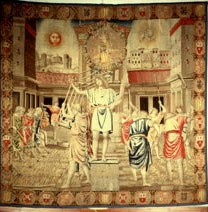
****
http://www.storiadimilano.it/Arte/arazzi_trivulzio.htm
Storia de Milano has a report to them and a few more pictures.
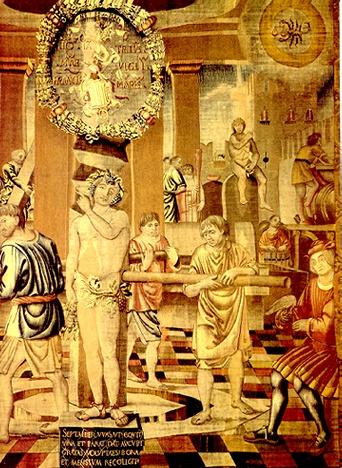
should be November (detail), see Scorpio ... but the picture name is Settembre (?) and the scorpio has a libra (?)
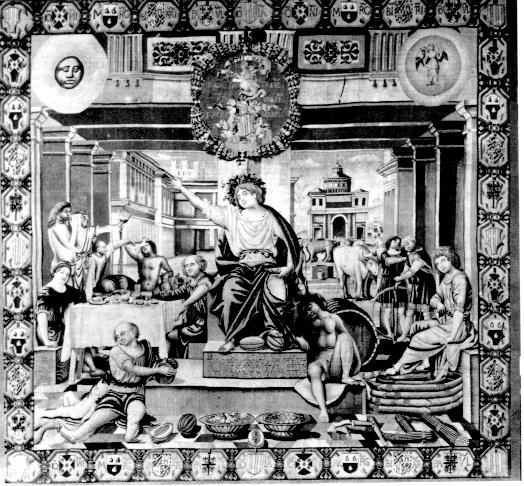
this picture is called agosto, the sign is Virgo
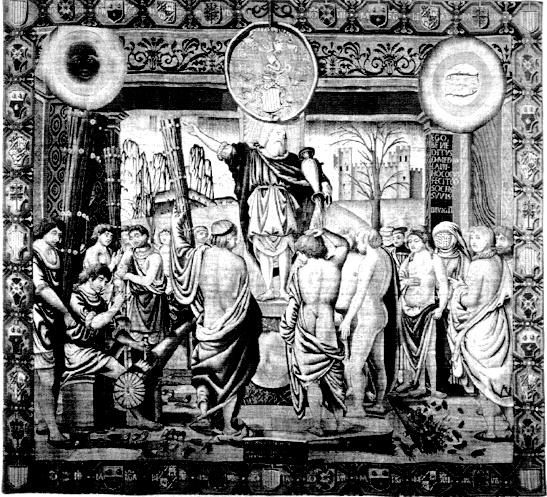
is called febbraio, the sign is Pisces
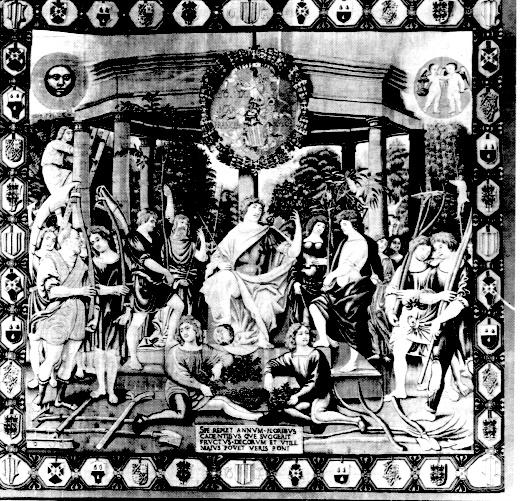
is called maggio, the sign is Gemini
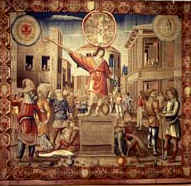
Gennaio
************************
Trivulzio, a long warrior's life
http://www.condottieridiventura.it/cond ... 0Magno.htm
(Italian language)
short Wiki
http://en.wikipedia.org/wiki/Gian_Giacomo_Trivulzio

*******************
For Tarot one has to calculate, that Trivulzio knew a lot of the Italian life and its conditions, serving for Milan and for Naples mainly till 1495. He was 3 years older than Galeazzo Maria Sforza and accompanied his escapades, partly being educated with him.
Probably he knew all, what one could know about Trionfi decks. Also he knew Italian mentality - likely in contrast to many French, who invaded Italy.
He started to work for France, when Naples was taken (1494). He himself negotiated a peace with the invaders, being the major general of Naples. In the battle of Fornovo (at river Taro 1495) he fought at the side of France. In 1498 he was chosen by the new French King Louis as major general and as this he had major merit, when Milan was taken 1499/1500.
Trivulzio had left his home city Milan 1488 for Naples, cause Lodovico preferred the young Sanseverino, a famous tournament hero and salon knight.
In 1500 Trivulzio returned back, victorious, and Lodovico went into a French prison. Sanseverino had been a loser.
If Louis XII. had the idea to influence the mood of the Milanese population with the import of French Taraux cards (and the documents point to a "propaganda action"), it might well be, that Trivulzio was his adviser.
Between 1496 and 1499 he had a major function in Asti, Piedmont.
... Asti, Piedmont ...
... Asti, Piedmont ...
... Asti, Piedmont ...
... Asti, Piedmont ...
*******
Later added
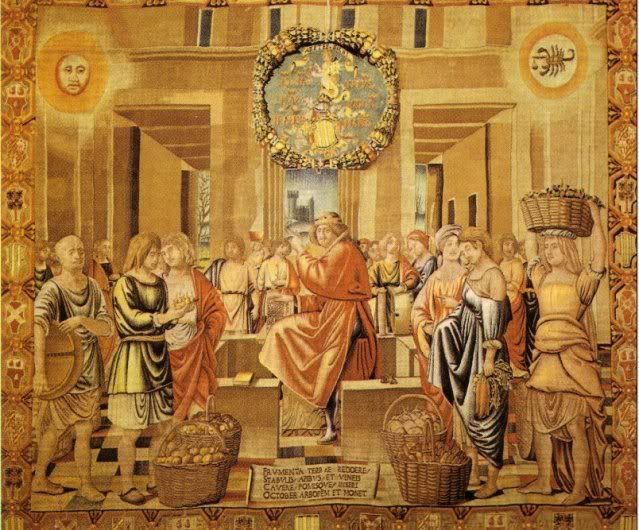
November picture ... with comment: "The panel shows farmers come back from the fairy of St. Martin, on the 21st November"
http://heavenastrolabe.wordpress.com/20 ... much-more/
so he knew also, how cards were played in Piedmont.
I detected a nice piece of tapestry, made for Trivulzio:

"December"
from the 12-piece "Trivulzio Months"
Design by Bramantino, 1501-04
Woven in the workshop of Benedetto da Milano, Vigevano, ca. 1503-09
wool and silk, 447 x 503 cm
Civiche Raccolte d'Arte Applicata, Castello Sforzesco, Milan
http://www.artnet.com/Magazine/FEATURES ... 5-16-6.asp
December, woven in Milan, measures more than 14 by 16 feet and depicts the making of sausages. This unpromising subject turns deeply sensual. In the center, a yummy exchange takes place between a young maiden looking at some very phallic, somewhat tumescent sausage casings, and a young man who eyes her from behind. It's like some sexy French film where the pretty shopkeeper and the gardener tryst. Adding to the erotic tension, a man blows up a pig bladder as another tends a fire.
... so says a comment. The man with the dangerous tool is naturally Saturn, who rules about Capricorn.
I found another, very small

****
http://www.storiadimilano.it/Arte/arazzi_trivulzio.htm
Storia de Milano has a report to them and a few more pictures.

should be November (detail), see Scorpio ... but the picture name is Settembre (?) and the scorpio has a libra (?)

this picture is called agosto, the sign is Virgo

is called febbraio, the sign is Pisces

is called maggio, the sign is Gemini

Gennaio
************************
Trivulzio, a long warrior's life
http://www.condottieridiventura.it/cond ... 0Magno.htm
(Italian language)
short Wiki
http://en.wikipedia.org/wiki/Gian_Giacomo_Trivulzio

*******************
For Tarot one has to calculate, that Trivulzio knew a lot of the Italian life and its conditions, serving for Milan and for Naples mainly till 1495. He was 3 years older than Galeazzo Maria Sforza and accompanied his escapades, partly being educated with him.
Probably he knew all, what one could know about Trionfi decks. Also he knew Italian mentality - likely in contrast to many French, who invaded Italy.
He started to work for France, when Naples was taken (1494). He himself negotiated a peace with the invaders, being the major general of Naples. In the battle of Fornovo (at river Taro 1495) he fought at the side of France. In 1498 he was chosen by the new French King Louis as major general and as this he had major merit, when Milan was taken 1499/1500.
Trivulzio had left his home city Milan 1488 for Naples, cause Lodovico preferred the young Sanseverino, a famous tournament hero and salon knight.
In 1500 Trivulzio returned back, victorious, and Lodovico went into a French prison. Sanseverino had been a loser.
If Louis XII. had the idea to influence the mood of the Milanese population with the import of French Taraux cards (and the documents point to a "propaganda action"), it might well be, that Trivulzio was his adviser.
Between 1496 and 1499 he had a major function in Asti, Piedmont.
... Asti, Piedmont ...
... Asti, Piedmont ...
... Asti, Piedmont ...
... Asti, Piedmont ...
*******
Later added

November picture ... with comment: "The panel shows farmers come back from the fairy of St. Martin, on the 21st November"
http://heavenastrolabe.wordpress.com/20 ... much-more/
so he knew also, how cards were played in Piedmont.
Last edited by Huck on 19 Dec 2009, 15:38, edited 3 times in total.
Huck
http://trionfi.com
http://trionfi.com
Re: Bolognese sequence
75Libra wasn't a sign of the zodiac until the 1st century b.c. (something I read recently on the Internet, but I can't remember where). Before that, Scorpio spanned two months. Then some representations had a scales in the scorpion's claws.
It may be significant that Allesandro Sforza got his daughter married Ginevra to Sante Bentivoglio in 1452, in a deal arranged by Francesco Sforza. It was a rush job because they were afraid of papal opposition. She was two years shy of marriagable age, so she didn't move to Bologna until 1454. There she became the grand lady of Bolognese society, marrying the next ruler, Giovanni II (Sante's cousin's son), after Sante's death in 1467, and continuing to rule Bolognese society for 50 more years. Her portrait by the Ferrarese painter Roberti is well known (http://www.artexpertswebsite.com/pages/ ... ercole.php). At the end, 1507, she hastened the demise of the Bentivoglios by goading her sons into rash acts. Then their houses were destroyed, probably before they had time to remove their belongings. Annibale II made an attempt to rule in 1513, but failed and went to his wife's town of Ferrara, where his descendants remained. A lesser branch remained in Bologna. Most of my information is fromThe Bentivoglios of Bologna, 1938, by Cecilia Ady. I hope it's accurate. She cites credible records.
Here is what I think may be Ginevra's significance, if she was a fan of the tarot. Let me go over some Bolognese history first. In 1435, as Ross says, Antongaleazzo Bentivoglio, a Bolognese lawyer friendly with Cosmo di Medici, was murdered by soldiers after being allowed entry into Bologna by the papacy. His entry had been in grand style, and the murder was attributed to the Church ("It seemed to the priests that he was too much loved," said Fileno della Tuata, Ady p. 16): hence the betrayal after a prior triumphal entry. After that, the papacy ruled directly and dictatorially for three years, with Eugenius IV's personal presence. This was the time when the papacy was incensed about Basel and the antipope Felix V. So there were two popes. But it seems to me that it was not a good time to be selling card games with even one pope on them, as the authorities might not be amused.
After that came the rule by Milan under Niccolo Piccinino, who turned over the city briefly to Annibale Bentivoglio. At the same time, May 1441, Annibale married Donnina Visconti, a kinswoman of Filippo. Then Piccinino lost his job with Filippo; he decided to take over Bologna for himself and had his son Francesco imprison Aninibale, first luring him out of Bologna for the purpose (autumn 1442). Annibale eventually escaped and imprisoned Francesco (June 1443). Then Annibale's enemies within Bologna murdered him, June 1445. However the Bentivoglio faction prevailed, and invited Sante Bentivoglio to leave Florence and become their first citizen. Again, this would have been seen by the citizens as a very unstable time, not a time to risk offending someone.
Sante had grown up in Tuscany and spent his last few years as an apprentice to a wool merchant in Florence. He was apparently friends with Giovanni di Medici then. A dozen letters survive between the two, from later years, in the Florence archives. Perhaps they played Trionfi together. In any case, there would then have been much exchange between Florence and Bologna. It is 1446 and getting propitious for Bologna to have its own Trionfi style. Sante, knowing the fate of his kinsmen all too well, retained a healthy distrust of the priests and died of natural causes.
The next major event is that in 1450 Bessarion became papal legate in Bologna, a post lasting until 1455, although he visited again in 1459 before and after the Congress of Mantua. Bessarion was an Eastern prelate who had negotiated unity between the Eastern Church and the Western Church. When the deal was rejected by the Eastern Church, he joined the Western Church. He was a friend of Cusa's and might have picked up an interest in games from him. For him, the two emperors would have been the East and West (as we see in the Florentine Minchiate), and the two popes the Patriarch in Constantinople and the Pope in Rome. But there were also the two popes in the West, namely Eugenius IV plus Felix V, who finally resigned in 1449. So perhaps it was best left vague who the two were. Nicholas V remained, made his capitulations, and the papacy was liked again in Bologna.
In 1452 comes the marriage with Ginevra Sforza, who arrives in Bologna 1454. These two years would have been an excellent time to prepare a painted wedding deck, guided by Bessarion, who might have promoted his ideal of the two popes and two emperors of equal rank. Constantinople fell in 1453, the Eastern Emperor presumed dead. I can imagine that in following years, some might even make it four popes, the two previous ones in the west and two in the east (Constantinople and Muscovy, which was now claiming to be the Eastern Empire, per Wikipedia). I can see the BAR Chariot card (assuming it is Bolognese) as Sante coming from Florence, bearing the Florentine lily on his cart. (Or perhaps it is a Florentine design from after the Medici adopted the French lily )
The years following are years of peace, prosperity, and relative independence for Bologna. The Bentivoglios continued contracting marriage alliances, notably Annibale II with Ercole d'Este's daughter Lucrezia in 1487, and later Allesandro with Ippolita Sforza (granddaughter of Galeazzo Maria). One of the daughters married Antonio Pico, and another married Pandolfo Malatesta (Ady, genealogical tree). I would imagine various tarot iconographic alternatives floating around during this time, because of all the familial connections with other tarot-rich cities (Ferrara, Milan, Florence). During this time, too, the "two popes" idea might have appealed to the Savoyards, who after 1467 were allies of Milan and hence Bologna; it was their former duke who had been the other pope, in one way of looking at the two. Before 1468, they had been hostile to the Sforzas, as he had part of what they considered their territory; and Marie of Savoy considered herself to be the rightful.heir to Milan.
In 1513 Bologna settled into relative obscurity and allowed itself to be ruled by the papal legates. It is then that the four figures start looking like Moors, due to papal domination, according to Kaplan (Vol 1 p. 49)--but perhaps you have better information. It is not surprising that the tarot remained stable for centuries under such conditions. The political situation did not change until Napoleon, three centuries later.
It may be significant that Allesandro Sforza got his daughter married Ginevra to Sante Bentivoglio in 1452, in a deal arranged by Francesco Sforza. It was a rush job because they were afraid of papal opposition. She was two years shy of marriagable age, so she didn't move to Bologna until 1454. There she became the grand lady of Bolognese society, marrying the next ruler, Giovanni II (Sante's cousin's son), after Sante's death in 1467, and continuing to rule Bolognese society for 50 more years. Her portrait by the Ferrarese painter Roberti is well known (http://www.artexpertswebsite.com/pages/ ... ercole.php). At the end, 1507, she hastened the demise of the Bentivoglios by goading her sons into rash acts. Then their houses were destroyed, probably before they had time to remove their belongings. Annibale II made an attempt to rule in 1513, but failed and went to his wife's town of Ferrara, where his descendants remained. A lesser branch remained in Bologna. Most of my information is fromThe Bentivoglios of Bologna, 1938, by Cecilia Ady. I hope it's accurate. She cites credible records.
Here is what I think may be Ginevra's significance, if she was a fan of the tarot. Let me go over some Bolognese history first. In 1435, as Ross says, Antongaleazzo Bentivoglio, a Bolognese lawyer friendly with Cosmo di Medici, was murdered by soldiers after being allowed entry into Bologna by the papacy. His entry had been in grand style, and the murder was attributed to the Church ("It seemed to the priests that he was too much loved," said Fileno della Tuata, Ady p. 16): hence the betrayal after a prior triumphal entry. After that, the papacy ruled directly and dictatorially for three years, with Eugenius IV's personal presence. This was the time when the papacy was incensed about Basel and the antipope Felix V. So there were two popes. But it seems to me that it was not a good time to be selling card games with even one pope on them, as the authorities might not be amused.
After that came the rule by Milan under Niccolo Piccinino, who turned over the city briefly to Annibale Bentivoglio. At the same time, May 1441, Annibale married Donnina Visconti, a kinswoman of Filippo. Then Piccinino lost his job with Filippo; he decided to take over Bologna for himself and had his son Francesco imprison Aninibale, first luring him out of Bologna for the purpose (autumn 1442). Annibale eventually escaped and imprisoned Francesco (June 1443). Then Annibale's enemies within Bologna murdered him, June 1445. However the Bentivoglio faction prevailed, and invited Sante Bentivoglio to leave Florence and become their first citizen. Again, this would have been seen by the citizens as a very unstable time, not a time to risk offending someone.
Sante had grown up in Tuscany and spent his last few years as an apprentice to a wool merchant in Florence. He was apparently friends with Giovanni di Medici then. A dozen letters survive between the two, from later years, in the Florence archives. Perhaps they played Trionfi together. In any case, there would then have been much exchange between Florence and Bologna. It is 1446 and getting propitious for Bologna to have its own Trionfi style. Sante, knowing the fate of his kinsmen all too well, retained a healthy distrust of the priests and died of natural causes.
The next major event is that in 1450 Bessarion became papal legate in Bologna, a post lasting until 1455, although he visited again in 1459 before and after the Congress of Mantua. Bessarion was an Eastern prelate who had negotiated unity between the Eastern Church and the Western Church. When the deal was rejected by the Eastern Church, he joined the Western Church. He was a friend of Cusa's and might have picked up an interest in games from him. For him, the two emperors would have been the East and West (as we see in the Florentine Minchiate), and the two popes the Patriarch in Constantinople and the Pope in Rome. But there were also the two popes in the West, namely Eugenius IV plus Felix V, who finally resigned in 1449. So perhaps it was best left vague who the two were. Nicholas V remained, made his capitulations, and the papacy was liked again in Bologna.
In 1452 comes the marriage with Ginevra Sforza, who arrives in Bologna 1454. These two years would have been an excellent time to prepare a painted wedding deck, guided by Bessarion, who might have promoted his ideal of the two popes and two emperors of equal rank. Constantinople fell in 1453, the Eastern Emperor presumed dead. I can imagine that in following years, some might even make it four popes, the two previous ones in the west and two in the east (Constantinople and Muscovy, which was now claiming to be the Eastern Empire, per Wikipedia). I can see the BAR Chariot card (assuming it is Bolognese) as Sante coming from Florence, bearing the Florentine lily on his cart. (Or perhaps it is a Florentine design from after the Medici adopted the French lily )
The years following are years of peace, prosperity, and relative independence for Bologna. The Bentivoglios continued contracting marriage alliances, notably Annibale II with Ercole d'Este's daughter Lucrezia in 1487, and later Allesandro with Ippolita Sforza (granddaughter of Galeazzo Maria). One of the daughters married Antonio Pico, and another married Pandolfo Malatesta (Ady, genealogical tree). I would imagine various tarot iconographic alternatives floating around during this time, because of all the familial connections with other tarot-rich cities (Ferrara, Milan, Florence). During this time, too, the "two popes" idea might have appealed to the Savoyards, who after 1467 were allies of Milan and hence Bologna; it was their former duke who had been the other pope, in one way of looking at the two. Before 1468, they had been hostile to the Sforzas, as he had part of what they considered their territory; and Marie of Savoy considered herself to be the rightful.heir to Milan.
In 1513 Bologna settled into relative obscurity and allowed itself to be ruled by the papal legates. It is then that the four figures start looking like Moors, due to papal domination, according to Kaplan (Vol 1 p. 49)--but perhaps you have better information. It is not surprising that the tarot remained stable for centuries under such conditions. The political situation did not change until Napoleon, three centuries later.
Last edited by mikeh on 18 Dec 2009, 09:58, edited 1 time in total.
Re: Bolognese sequence
76hi Mike,
If Ginevra Sforza had a Trionfi deck (which seems not unlikely, given her rank), she would have gotten it probably from her father, who is said to have been interested in cards.
I know that (although I think, it changed earlier), but it's ca. 1503 and the description says 12 month-pictures. If this was September/Libra, how looked October/Scorpio?mikeh wrote:Libra wasn't a sign of the zodiac until the 1st century b.c. (something I read recently on the Internet, but I can't remember where). Before that, Scorpio spanned two months. Then some representations had a scales in the scorpion's claws.
I think, the "Bentivoglio of Bologna" are those "Bentivoglio in Ferrara", the family moved to Ferrara. Annibale's wife had been Lucretia d'Este. And Ferrara wasn't at the side of Julius.It may be significant that Allesandro Sforza got his daughter married Ginevra to Sante Bentivoglio in 1452, in a deal arranged by Francesco Sforza. It was a rush job because they were afraid of papal opposition. She was two years shy of marriagable age, so she didn't move to Bologna until 1454. There she became the grand lady of Bolognese society, marrying the next ruler, Giovanni II (Sante's cousin's son), after Sante's death in 1467, and continuing to rule Bolognese society for 50 more years. Her portrait by the Ferrarese painter Roberti is well known (http://www.artexpertswebsite.com/pages/ ... ercole.php). At the end, 1507, she hastened the demise of the Bentivoglios by goading her sons into rash acts. Then all of the Bentivoglios' houses were destroyed, probably before they had time to remove their belongings. They made one more attempt to rule, in 1513, but after that there were the Bentivoglios of Ferrara. I have been reading The Bentivoglios of Bologna, 1938, by Cecilia Ady. I hope it's accurate. She cites credible records.
Any details about the triumphal entry?Here is what I think may be Ginevra's significance, if she was a fan of the tarot. Let me go over some Bolognese history first. In 1435, as Ross says, Antongaleazzo Bentivoglio, a Bolognese lawyer associated with Cosmo di Medici, was murdered by soldiers after being allowed entry by the papacy. His entry had been in grand style, and the murder was attributed to that very papacy ("It seemed to the priests that he was too much loved," said Fileno della Tuata, Ady p. 16): hence the betrayal after a prior triumphal entry.
If the 2 Emperors found entry to trionfi decks in this early time, they might have entered around 1450-52 (Florence 1450, Siena 1452), situations for which we've real confirmation, that something had happened.After that the papacy ruled directly and dictatorially for three years, with Eugenius IV's personal presence. This was the time when the papacy was incensed about Basel and the antipope Felix V.I agree, that the authorities weren't probably amused about cards.So there were two popes. But it seems to me that it was not a good time to be selling card games with even one pope on them, as the authorities might not be amused.
But it happened later, that Felix V. was definitely elected Pope. "The Council of Basle deposed Pope Eugenius IV on June 24, 1439; and had Duke Amedeo VIII elected pope (antipope) on November 5, 1439, by one cardinal, Louis Aleman; eleven bishops (3); seven abbots; and fourteen theologians; the election was irregular."
http://www.fiu.edu/~mirandas/bios1449.htm#Savoie
And of Eugen it's the far spread version, "In the following May, 1434, a revolution, fomented by the pope's enemies, broke out in Rome. Eugene, in the garb of a monk, and pelted with stones, escaped down the Tiber to Ostia, whence the friendly Florentines conducted him to their city and received him with an ovation. He took up his residence in the Dominican convent of Santa Maria Novella, and sent Vitelleschi, the militant Bishop of Recanati, to restore order in the States of the Church."
http://www.newadvent.org/cathen/05601a.htm
But already Ross said, that he spend some of his time then in Bologna. How much of it?
"The Pope moved to Bologna in April of 1436. His condottieri Francesco Sforza and Vitelleschi in the meantime reconquered much of the Papal States. Traditional papal enemies such as the Prefetti di Vico
Prefetti di Vico were destroyed, while the Colonna were reduced to obedience after the destruction of their stronghold in Palestrina (August, 1436)"
http://www.absoluteastronomy.com/topics/Pope_Eugene_IV
In January 1438 or little later he was in Ferrara. So he had less than 2 years in Bologna ... if he didn't spend some time elsewhere. Was it in this time, that he attempted to kill Sforza?
Reading the biography of Eugen (cardinal since 1408) I stumbled about this:
"Attended the Council of Constance. Participated in the conclave of 1417, which elected Pope Martin V. Named vicar of the pope and legate a latere in Marche Anconitana on January 3, 1420; he left the Roman Curia the following February 8. Named legate in Bologna in August 1423; returned to Rome on August 24, 1424."
This means, that Eugen (born in Venice, studied in Padova, "bishop of Siena" and cardinal in 1408 ... with 22 years ? ... aha, his uncle was a pope, Gregory XII, who abdicated in Constance, so early nepotism and very early orientated towards "power")
was precisely that one year a mighty man in Bologna, when San Bernardino had his great show there inclusive playing card burning. ... this explains Eugen's later close relationship to the Franciscans and his negative influence against playing card production in the 40's.
Strange enough, it's also the time, when Leon Battista Alberti in Bologna got sick, "lost his memory" and wrote his Philodoxus.
It's also the year, when Carlo Malatesta - who abdicated in Constance in the name of Gregory XII - was captured by Filippo Maria Visconti and became then "honoured guest" in Abbiategrasso for a 3/4 year, probably with playing cards activities ... Pandolfo was captured in July 1424 (battle of Zagonara) and in August the later Pope Eugen had to leave Bologna, back to Rome. Well, that looks like coordinated action.
Malatesta fought for Florence.
"Visconti: 4000 cavalli, 4000 fanti; fiorentini: 8000/9000 cavalli e 2000/3000 fanti. Durata: 5 ore. Scontro tra due cavallerie pesanti sotto una pioggia dirotta che colpisce di traverso i fiorentini (stanchi peraltro per una lunga marcia) quasi accecandoli, mentre i viscontei l’hanno alle spalle. I milanesi incominciano a ritirarsi portando i fiorentini su un luogo paludoso dove sono disfatti da Angelo della Pergola. Secondo i calcoli del Morelli i fiorentini perdono 5000 cavalli e 2000 fanti; per l’Albizzi 2600 cavalli; per l’Ammirato ed il Cambi 3200 cavalli e tutti i bagagli. I fiorentini subiscono un danno valutato sui 300000 scudi."
Big victory, heavy losses. Antongaleazzo Bentivoglio had been also at the losing side, but wasn't captured (or relleased ?)... that's the one, who is "decapitato" in 1435.
That's the time, that we once considered as plausible for the production of the Michelino deck (cause this enduring meeting between Carlo Malatesta and Filippo Maria, who already had started to live "lonesome" - although Carlo was prisoner, this should have been a highlight of their lifes to both of them; part of the "splendid mood" of Filippo should have been, that Filippo's maitresse was pregnant since July). Generally it's also the height of Filippo Maria's fighting successes.
Generally it's a little unclear, what happened with Eugen in Bologna 1436-37. The intention to have the council in Bologna, seems to have been from an earlier date ... or is this wrong? There are so many discussions, council in Basel or in Italy, critique, threats, the opinion of the Greek side, that's all rather complex.
When Piccinino became prisoner of Annibale?After that came the rule by Milan under Niccolo Piccinino, who turned over the city briefly to Annibale Bentivoglio. At the same time, May 1441, Annibale married Donnina Visconti, a kinswoman of Filippo. But then Piccinino lost his job with Filippo; he decided to take over Bologna for himself and imprisoned Annibale. Annibale eventually escaped and imprisoned Piccinino. Then Annibale's enemies within Bologna murdered him, 1445....However the Bentivoglio faction prevailed, and invited Sante Bentivoglio to leave Florence and become their first citizen. Again, this would have been seen by the citizens as a very unstable time, not a time to risk offending someone.
Sante had grown up in Tuscany and spent his last few years as an apprentice to a wool merchant in Florence. He was apparently friends with Giovanni di Medici then. A dozen letters survive between the two, from later years, in the Florence archives. Perhaps they played Trionfi together.... cause they wrote letters, they played Trionfi together?
The Florentians were rather negative about card playing in the 40's.In any case, there would then have been much exchange between Florence and Bologna. It is 1446 and getting propitious for Bologna to have its own Trionfi style. Sante, knowing the fate of his kinsmen all too well, retained a healthy distrust of the priests and died of natural causes.
Cusa prohibited cards in 1455. In this time St. Capistranus burnt playing cards in Germany, a preacher in Padova gives critical words to Trionfi cards (1455) and a jurist in Ferrara writes defending words (1456).The next major event is that in 1450 Bessarion became papal legate in Bologna, a post lasting until 1455, although he visited again in 1459 before and after the Council of Mantua. Bessarion was an Eastern prelate who had negotiated unity between the Eastern Church and the Western Church. When the deal was rejected by the Eastern Church, he joined the Western Church. He was a friend of Cusa's and might have picked up an interest in games from him.
We've to assume, that 1450-52 society (peace, Jubilee year, Emperor visit) opened for playing cards (after the anti-gaming Eugen-period), but closed again for some time later with the exception of specific regions in Northern Italy (Ferrara, Milan, possibly also some others).
We've in 1460's an opening of the liberal humanistic tendencies with accademia Romana and other platonic oriented academies etc. And then, in 1462 (not before) Cusanus writes about a game "De Ludo Globi", in which he excuses some "gaming" as of "educational worth ... but he about something like Bocchia or Petanque, "Kugeln", not about playing cards.
Greeks transported usually old Greek texts to Italy, the Renaissance and its art was produced by Italians themselves - usually. Greek texts and the related texts had a stimulating effect - that's true. ... .-) ... but better don't attempt to make Bessarion a playing card producer.For him, the two emperors would have been the East and West (as we see in the Florentine Minchiate), and the two popes the Patriarch in Constantinople and the Pope in Rome. But there were also the two popes in the West, namely Eugenius IV plus Felix V, who finally resigned in 1449. So perhaps it was best left vague who the two were. Nicholas V remained, made his capitulations, and the papacy was liked again in Bologna.
In 1451 or 1452 Bessarion brings the Renaissance art scene to Bologna, no doubt with Sante's approval.
Indeed there is a report, that the Greek Emperor played a game, at a strange event, when the whole delegation didn't find a living place for the night and got the help of a humble citizen ... he played at tables.
...
In 1452 comes the marriage with Ginevra Sforza, who arrives in Bologna 1454. These two years would have been an excellent time to prepare a wedding deck, guided by Bessarion, who might have promoted his ideal of the two popes and two emperors of equal rank.
...
If Ginevra Sforza had a Trionfi deck (which seems not unlikely, given her rank), she would have gotten it probably from her father, who is said to have been interested in cards.
Huck
http://trionfi.com
http://trionfi.com
Re: Bolognese sequence
77Wow, you start early in the day, Huck (assuming you are nine hours ahead of me, clock time). I had already written some second thoughts, before going to bed, and there you are, already done. As usual, you make me dig deeper.
Huck wrote:
Huck wrote:
Huck wrote:
As to the date: Well, sometimes an old medallion with a zodiac on it turned up, when people were digging up the ground to build things, or cleaning out an old sarcophagus for re-use. Or maybe it was in an old manuscript, maybe one brought over from Greece. I don't know what October would have been: a scorpion without a scales? I will keep my eye out for scorpions on Months.I know that (although I think, it changed earlier), but it's ca. 1503 and the description says 12 month-pictures. If this was September/Libra, how looked October/Scorpio?
The book, The Bentivoglio of Bologna is about just Bologna. It is only at the end of the book that she says that Annibale and Lucretia moved to Ferrara, in 1513. And one branch of the family, descended from a Ludovico Bentivoglio, stayed in Bologna and was still there in 1938, owning the same palace. What I said wasn't clear; I rewrote it.I think, the "Bentivoglio of Bologna" are those "Bentivoglio in Ferrara", the family moved to Ferrara. Annibale's wife had been Lucretia d'Este. And Ferrara wasn't at the side of Julius
Well, it isn't exactly like on a Chariot card. First they send Sante money for proper clothing, telling him what to buy, and to pay for "three servants and a boy." His entry is going to be more like Jesus's into Jerusalem than Pontius Pilate's. After all, he's there to secure a republic, not dissolve one, like Caesar. For the actual event, here's Ady's translation of a letter from Ser Cola to Filippo Manetti, the two architects, Bolognese and Florentine, of Sante's return. Bear in mind that Sante's existence as a grandson of Giovanni I Bentivoglio had been kept a secret from everyone, including perhaps Sante himself, for 21 years. Words in brackets are Ady's, p. 36f:Any details about the triumphal entry?
So here the triumphal entry comes first, and then we see whether the hero will act with temperance, courage, and justice. It is like when we in the US elect a President: there is the Inauguural Parade first, then we see. I am slightly reminded of Francesco Sforza's entry into Milan, on horseback passing out bread for the people, after which it still remained to prove himself as a ruler (although he had already waged war, like Caesar, and did indeed come to dissolve a republic). In Sante's case, the first task was the negotiations with Nicholas V, which ended with the capitulations of 1447. And later, 1454, getting the great powers' guarantee of support against possible papal encroachment upon Bologna's republican government.Filippo. My pen cannot describe the honour which has been shown to our Magnifico Messer Sante on his entry, which he made to day, at xxii. But to tell you only a part, some three hundred citizens rode out to meet him, including Magnifico Piero di Navarino, captain of our forces, and Alberto Orlanno, secretary of the illustrious Conte Francesco [Guidi], and other doctors and knights. First of all he went to visit the Signori Anziani, who would not let him leave the palace until he had been knighted, and the ceremony was performed with such triumph as tongue cannot tell. Then he went to the house [of the Bentivoglio] with all the company, ad the rest of the citizens followed on foot. When they arrived there was a magnificent feast and sixty boxes of sweetmeats were distributed. In the evening, when they were at supper, a band of noble citizens, men and women, were seen coming uup the street: if the Emperor himself had been present there would not have been half the number. The ladies of the house have welcomed him as if he were their son, and they have accepted him as a son. Also I must tell you, that when he was knighted, Messer Bornio da Sala, a valiant orator, made a very fine speech; Sante replied appropriately and elegantly, in a speech of about forty words which was worthy of a Cicero or a Demosthenes; he was praised by all as a youth of merit and they said that he had set a splendid standard for his actions and had made a good beginning. I pray God that the middle and the end may be likewise. If I were to tell you every particular ten pages would not suffice me. Please tell Neri and Gino Capponi about it and commend me to them and to my other friends. I commend myself to you.
1446, on the 14th of November, from Bologna. Coda. I am writing further to you of something which I had forgotten. Before Messer Sante entered the city, about eight hundred children went to San Giacomo and took a banner with the arms of the Bentivoglio out fo the Church; they went ot meet him at the gate and accompanied him to the Piazza and to his house with this banner, crying, "Viva la sega," and "Sega, sega, sega." Young and old, men and women took up the cry and the streets and porticoes were full of people who raised their arms to heaven and said, "He has come to avenge the blood of Annibale on the traitors who slew him"; every one wept with emotion and much else happened of which pen cannot write. Filippo, yesterday when Sante was knighted a gilded cuirass was placed on him, and his own was taken from him as largesse, so that he wants you to have another made of the same kind as the first. I will send the money when you let me know.
Huck wrote:
In her discussion of the negotiations around the capitulations, Ady says that Basel had appealed to Bologna to recognize Felix, but Bologna stayed with Eugenius, She doesn't give a specific date, but it must have been after Piccinnino freed the city from papal rule in 1438, and before he came back again, after Milan discharged him, to take it back into the papal fold in 1442.But it happened later, that Felix V. was definitely elected Pope.
Ady says that "Eugenius IV's personal presence in Bologna from April 1436 to January 1438 postponed its [the government's] fall, but, in the meantime, the citizens were united in their hatred of the sinister trio who ruled in his name" (p. 17). This trio was Baldassare da Offida, the Podesta; Gaspare da Offida, who ran the Bollette; and Daniele, Bishop of Condordia, the Governor. Baldassare "extorted large sums of money from the citizens and obliged those who sought audience with him to address him kneeling; yet he stood so high in the Pope's favour that no one, even if he were a cardinal, dare say a word against him," Ady says, with citations, giving examples of the others' audacities as well. So "the friends of the Bentivoglio" wrote to Milan to send Piccinino to rescue them, and opened the gate for him and his men when they arrived, May 20 1438.Generally it's a little unclear, what happened with Eugen in Bologna 1436-37
Actually, it was Piccinino's son Francesco who had imprisoned Annibale on Niccolo's orders, in autumn 1442--I had forgotten to make that correction to my draft--and got imprisoned in turn, June 1443. There's a long, colorful story in between that I didn't go into.When Piccinino became prisoner of Annibale?
Yes, I should have said more. Ady: "...he did not wish to leave Florence. Here, in company with his friend Giovanni dei Medici, Cosimo's second son, he tasted the many-sided delights of Florentine life, which had once caused Dante to turn aside from his true path" (p. 34). Ady cites the letters here. Giovanni was a year older than Sante and died a month after him. Well, if the Florentines were negative about card-playing, maybe they didn't play Triumphs. There were other amusements--or were the Florentines negative about them, too? (On the other hand, sometimes disapproval from one's elders makes an amusement more attractive to a youth.)cause they wrote letters, they played Trionfi together?
When did Cusa and Bessarion take their long sea voyage from Greece? I was thinking pre-1450, but maybe I have my dates mixed up. Maybe Cusa got an interest in games from Bessarion, I don't know. And Triumphs, to be acceptable to either of them, would have had to be presented as instructional.Cusa prohibited cards in 1455...And then, in 1462 (not before) Cusanus writes about a game "De Ludo Globi", in which he excuses some "gaming" as of "educational worth ... but he about something like Bocchia or Petanque, "Kugeln", not about playing cards.
I think you underestimate Bessarion. Ady: "Sante's Florentine associations combined with Bessarion's pre-eminence in the world of learning to bring fresh intellectual and artistic influences to bear upon the city." And there's Venturi, writing of Galasso Galassi, who in 1451 appraised some pennants with Cosme Tura in Ferrara: "After 1451...Galasso abandoned Ferrara, and at Bologna, whither he now repaired, he received orders from Cardinal Bessarione. He painted his portrait and also a picture of the Assumption in San Giovanni in Monte, where he frescoed a chapel..." (North Italian Painting in the Quattrocento: Emilia, 1931, p. 29). Venturi didn't give his sources, but there are 19th century Italian sources on Galasso mentioned in the Italian edition of Vasari in Google Books. Vasari vouches for the move to Bologna, but without giving a date. Bessarion reorganized the university and was involved in the day to day work of the Signoria, including the committee that provided for Sante's ample income ("in order that he may live honoourably according to his rank and condition," Ady (p. 49) quotes Sacco's Statuti as saying). Ady says that the only recorded clash with Sante was over Bessarion's "sumptuary edict" of March 1453, designed to "bridle the extravagant luxury of the Bolognese ladies." Sante's mistress led the opposition to this edict. And "when Sante's own wedding celebrations defied the restrictions," he had to go to a different church, the Augustinians' San Giacomo, to get married. Bessarion then excommunicated the Augustinians, an act later rescinded at Sante's request. Ady adds: "Did not Bessarion's own present to the bridal pair of twenty-four boxes of sweetmeats, twenty-four wax candles, six live peacocks, and a cask of malmsey show some appreciation of the pleasures of the world?" I can see a game with two emperors and two popes as constructed (perhaps at others' initiative, I will concede) precisely to appeal to the instructional side of Bessarion's nature, and using illustrations he would like. Venturi (p. 30f) thought that Galasso was responsible for the "Mantegna" designs, with arguments that to my knowledge have been ignored rather than refuted (yes, a discussion for another thread). If any of the extant works that Venturi attributes to Galasso are his (he gives reproductions of a few, not the "Mantegna," but similar style), that is no mean talent, and hardly Byzantine.Greeks transported usually old Greek texts to Italy, the Renaissance and its art was produced by Italians themselves - usually. Greek texts and the related texts had a stimulating effect - that's true. ... .-) ... but better don't attempt to make Bessarion a playing card producer.
Interesting. What confirmation are you thinking of?If the 2 Emperors found entry to trionfi decks in this early time, they might have entered around 1450-52 (Florence 1450, Siena 1452), situations for which we've real confirmation, that something had happened
Re: Bolognese sequence
78Huck: I think I will go into more detail about Annibale's imprisonment by Francesco Piccinino, escape, and imprisonment of Francesco. I don't myself see the relevance to the tarot sequence, but you're not likely to read it anywhere else, and if Annibale's murder is relevant, as Ross seems to think, maybe his earlier adventures are relevant, too, and somebody else will make the connection. The year is 1442. Here is Ady (p. 22):
"In the autumn Francesco Piccinino, acting on his father's orders, left his army in the field and had himself brought into Bologna on the plea of illness. Annibale and other prominent citizens visited him daily as he lay sick in the Bishop's palace. When he announced his intention of seeking change of air at San Giovanni in Persiceto and begged them to accompany him thither, they were forced to consent. On reaching San Giovanni, Romeo Pepoli and Giovanni Fantuzzi were allowed to return to Bologna, but Annibale, together with Gaspare Malvessi and his son Achille, was arrested, and all three were sent as prisoners to distant fortresses."
So Francesco goes back and lords it over Bologna, not telling anyone where the prisioners are. The rest of the story comes from Galeazzo Marescotti de' Calvi, Come Annibale Bentivoglio fu preso et menato de pregione et poi morto et vendicato , ed. Guidicini, written shortly after the events but published probably in 1489. Marescotti himself is the main actor in the story. One day in May 1443 a certain Genesio da Borgo San Donino, who earned his living by traveling round the country mending copper pots and pans (perhaps looking a bit like the Marseille or Cary Sheet Fool), came to Marescotti with a message from Annibale. The jailers had called him in to play chess with the captive while the castellan slept in an adjoining room. "Annibale had bidden him tell his friends in Bologna that he was at Varano in chains, and that he commended his cause to him," writes Ady. So Marescotti and friends try to rescue Annibale. The first attempt fails, but they try again, ignoring all advice not to try the impossible (so much for Prudence). After climbing the wall with ropes, Genesio opens the gate with his tools. His tools don't open the tower where Annibale is held, so they wait until the castellan calls his servant to open the door. With the element of surprise the rescuers get in, free Annibale, and surprise the garrison. Only the castellan was killed, when he tried to give the alarm after agreeing to cooperate. They keep everyone hidden until dusk, when they remove the clapper from the alarm bell and take hostages with them. When they get to the Taro River, they release the hostages, ford the stream, and carry poor Annibale to a village, where they spend the night pretending to be Piccinino's soldiers. Then they reach the house of one of the party at Spilamberto; Annibale rests while a messanger goes to Bologna. The populace suitably prepared, they go over the Bologna walls by ropes and ring the bell of S. Giacomo to call them to arms. Soon they are dragging Francesco Piccinino out onto the balcony, that the people might see that their betrayer is a prisoner. The people want him thrown down, but Annibale has him held to exchange for his friends who are still captive.
Annibale quickly gets a five year league with Florence and Venice. There is still one nearby castello held by Piccinino's men. Annibale has a trench dug to protect them from forays by the soldiers. "Doctors and students of the University, trade gilds under their banners, members of the religious orders, knights, peasants, Jews, all lent a hand with the work until the trench was finished. Bread and wine were supplied at the expense of the commune, and food was brought to the workers by the women and children." After two months the castello capitulates in return for 35,000 ducats. On that day, 7 August, the shops in Bologna open for the first time since Annibale's return. A week later comes the defeat of Milan's armies by the allied forces of Bologna, Florence, and Venice, with Annibale at their head. The contado is secure, and prisoners are exchanged. End of story, until the next part, the murder of Annibale, which you already know.
"In the autumn Francesco Piccinino, acting on his father's orders, left his army in the field and had himself brought into Bologna on the plea of illness. Annibale and other prominent citizens visited him daily as he lay sick in the Bishop's palace. When he announced his intention of seeking change of air at San Giovanni in Persiceto and begged them to accompany him thither, they were forced to consent. On reaching San Giovanni, Romeo Pepoli and Giovanni Fantuzzi were allowed to return to Bologna, but Annibale, together with Gaspare Malvessi and his son Achille, was arrested, and all three were sent as prisoners to distant fortresses."
So Francesco goes back and lords it over Bologna, not telling anyone where the prisioners are. The rest of the story comes from Galeazzo Marescotti de' Calvi, Come Annibale Bentivoglio fu preso et menato de pregione et poi morto et vendicato , ed. Guidicini, written shortly after the events but published probably in 1489. Marescotti himself is the main actor in the story. One day in May 1443 a certain Genesio da Borgo San Donino, who earned his living by traveling round the country mending copper pots and pans (perhaps looking a bit like the Marseille or Cary Sheet Fool), came to Marescotti with a message from Annibale. The jailers had called him in to play chess with the captive while the castellan slept in an adjoining room. "Annibale had bidden him tell his friends in Bologna that he was at Varano in chains, and that he commended his cause to him," writes Ady. So Marescotti and friends try to rescue Annibale. The first attempt fails, but they try again, ignoring all advice not to try the impossible (so much for Prudence). After climbing the wall with ropes, Genesio opens the gate with his tools. His tools don't open the tower where Annibale is held, so they wait until the castellan calls his servant to open the door. With the element of surprise the rescuers get in, free Annibale, and surprise the garrison. Only the castellan was killed, when he tried to give the alarm after agreeing to cooperate. They keep everyone hidden until dusk, when they remove the clapper from the alarm bell and take hostages with them. When they get to the Taro River, they release the hostages, ford the stream, and carry poor Annibale to a village, where they spend the night pretending to be Piccinino's soldiers. Then they reach the house of one of the party at Spilamberto; Annibale rests while a messanger goes to Bologna. The populace suitably prepared, they go over the Bologna walls by ropes and ring the bell of S. Giacomo to call them to arms. Soon they are dragging Francesco Piccinino out onto the balcony, that the people might see that their betrayer is a prisoner. The people want him thrown down, but Annibale has him held to exchange for his friends who are still captive.
Annibale quickly gets a five year league with Florence and Venice. There is still one nearby castello held by Piccinino's men. Annibale has a trench dug to protect them from forays by the soldiers. "Doctors and students of the University, trade gilds under their banners, members of the religious orders, knights, peasants, Jews, all lent a hand with the work until the trench was finished. Bread and wine were supplied at the expense of the commune, and food was brought to the workers by the women and children." After two months the castello capitulates in return for 35,000 ducats. On that day, 7 August, the shops in Bologna open for the first time since Annibale's return. A week later comes the defeat of Milan's armies by the allied forces of Bologna, Florence, and Venice, with Annibale at their head. The contado is secure, and prisoners are exchanged. End of story, until the next part, the murder of Annibale, which you already know.
Last edited by mikeh on 19 Dec 2009, 03:21, edited 1 time in total.
Re: Bolognese sequence
79I think, they went already 1506/1507 ... at least the women and the men were triggering around to see, what they could do against the change. Julius would have liked to get them, I would assume. Ferrara was against Julius. And as Ferrara and Bologna have only 40 km distance, the contact between the family was always vivid since the decision that Lucrezia should marry Annibale (1478). Annibale had then some time at Ferrara, he was like a son there. Giovanni, the father, died 1508.mikeh wrote:I think, the "Bentivoglio of Bologna" are those "Bentivoglio in Ferrara", the family moved to Ferrara. Annibale's wife had been Lucretia d'Este. And Ferrara wasn't at the side of JuliusThe book, The Bentivoglio of Bologna is about just Bologna. It is only at the end of the book that she says that Annibale and Lucretia moved to Ferrara, in 1513. And one branch of the family, descended from a Ludovico Bentivoglio, stayed in Bologna and was still there in 1938, owning the same palace. What I said wasn't clear; I rewrote it.
Well, that's a welcome with heart, not that, what it commonly the "big triumphal procession", with artful scenarios, allegoric motifs ... etc. (that, what made the Trionfi cards). That sort of show was not common in Bologna, I would assume ... all, what I read, the population has been quite special, not comparable to other cities. The Bentivoglio must have presented a sort of Robin-Hood-function for a longer time and so were "very" popular ... at least for their own party..Well, it isn't exactly like on a Chariot card. First they send Sante money for proper clothing, telling him what to buy, and to pay for "three servants and a boy." His entry is going to be more like Jesus's into Jerusalem than Pontius Pilate's.
...
1446, on the 14th of November, from Bologna. Coda. I am writing further to you of something which I had forgotten.
...
Similar to my local soccer-club ...
Actually, it was Piccinino's son Francesco who had imprisoned Annibale on Niccolo's orders, in autumn 1442--I had forgotten to make that correction to my draft--and got imprisoned in turn, June 1443. There's a long, colorful story in between that I didn't go into.When Piccinino became prisoner of Annibale?
[/quote]
I searched in the life of Niccolo Piccinino and didn't found it.
Giovanni died earlier (1463).....
Yes, I should have said more. Ady: "...he did not wish to leave Florence. Here, in company with his friend Giovanni dei Medici, Cosimo's second son, he tasted the many-sided delights of Florentine life, which had once caused Dante to turn aside from his true path" (p. 34). Ady cites the letters here. Giovanni was a year older than Sante and died a month after him. Well, if the Florentines were negative about card-playing, maybe they didn't play Triumphs. There were other amusements--or were the Florentines negative about them, too? (On the other hand, sometimes disapproval from one's elders makes an amusement more attractive to a youth.)
The Florentians accepted Petrarca's "Trionfi" ... and for the playing card development they had a pope in their city, who didn't like cards. In 1446/47 we have a Florentian "poetus laureatus", so a high-level intellectual, who was send to Pistoia, "a gambler's nest", to create some order there. Somehow he was able to open the hell on earth there with his ideas. This shouldn't have been possible, if Florence had been playing card tolerant in this time. When Sante left in 1446, they probably didn't play with Trionfi card.
This changed, when Sforza took Milan (and Cosimo was Sforza's banker) and Cosimo saw it as profitable to adapt Florence to Milanese customs (more tolerance for playing cards already under Filippo and that very early). Also some change happened by pope Nicholas immediately. But I think, that they dropped back to older prohibitive tendencies, when Cosimo lost some of his influence for some time.
The journey was before the council, and that started in January 1438 in Ferrara. But there were 700 participants, So we don't know, if there was much contact (if I remember correctly, Bessarion became of importance during the council, first he was a "second row man"). Also there was a language problem. And Cusanus left the delegation in Venice and went back to Germany.When did Cusa and Bessarion take their long sea voyage from Greece? I was thinking pre-1450, but maybe I have my dates mixed up. Maybe Cusa got an interest in games from Bessarion, I don't know. And Triumphs, to be acceptable to either of them, would have had to be presented as instructional.
I don't know, if it's possible, that both had something like "much contact" ever. For instance the congress at Mantova: Cusanus arrived late (Oktober or November), for instance he didn't see Sforza, who stayed only two weeks in September (and this were the most interesting - and most visited - moments). Cusa had contact to Toscanelli, both studied in Padova at the same time ... and other persons in Florence, the book collectors, who profited from Cusanus' German connections.
True is, that Enea Piccolomini had been much time in Germany. It's true, that Cusa was variously in Italy, but not long times mostly. Between Bessarion and Cusanus ... one should that look up, but I think, there was not much.
Bessarion had a house in Rome, open, everybody was there, Cusanus etc.. ...
... when was Cusanus definitely in Rome? That wasn't so often.
Well, the description says that, what I try to tell ...I think you underestimate Bessarion. Ady: "Sante's Florentine associations combined with Bessarion's pre-eminence in the world of learning to bring fresh intellectual and artistic influences to bear upon the city." And there's Venturi, writing of Galasso Galassi, who in 1451 appraised some pennants with Cosme Tura in Ferrara: "After 1451...Galasso abandoned Ferrara, and at Bologna, whither he now repaired, he received orders from Cardinal Bessarione. He painted his portrait and also a picture of the Assumption in San Giovanni in Monte, where he frescoed a chapel..." (North Italian Painting in the Quattrocento: Emilia, 1931, p. 29). Venturi didn't give his sources, but there are 19th century Italian sources on Galasso mentioned in the Italian edition of Vasari in Google Books. Vasari vouches for the move to Bologna, but without giving a date. Bessarion reorganized the university and was involved in the day to day work of the Signoria, including the committee that provided for Sante's ample income ("in order that he may live honoourably according to his rank and condition," Ady (p. 49) quotes Sacco's Statuti as saying). Ady says that the only recorded clash with Sante was over Bessarion's "sumptuary edict" of March 1453, designed to "bridle the extravagant luxury of the Bolognese ladies." Sante's mistress led the opposition to this edict. And "when Sante's own wedding celebrations defied the restrictions," he had to go to a different church, the Augustinians' San Giacomo, to get married. Bessarion then excommunicated the Augustinians, an act later rescinded at Sante's request. Ady adds: "Did not Bessarion's own present to the bridal pair of twenty-four boxes of sweetmeats, twenty-four wax candles, six live peacocks, and a cask of malmsey show some appreciation of the pleasures of the world?" I can see a game with two emperors and two popes as constructed (perhaps at others' initiative, I will concede) precisely to appeal to the instructional side of Bessarion's nature, and using illustrations he would like. Venturi (p. 30f) thought that Galasso was responsible for the "Mantegna" designs, with arguments that to my knowledge have been ignored rather than refuted (yes, a discussion for another thread). If any of the extant works that Venturi attributes to Galasso are his (he gives reproductions of a few, not the "Mantegna," but similar style), that is no mean talent, and hardly Byzantine.
"Ady says that the only recorded clash with Sante was over Bessarion's "sumptuary edict" of March 1453, designed to "bridle the extravagant luxury of the Bolognese ladies." Sante's mistress led the opposition to this edict. And "when Sante's own wedding celebrations defied the restrictions," he had to go to a different church, the Augustinians' San Giacomo, to get married. Bessarion then excommunicated the Augustinians, an act later rescinded at Sante's request."
Whow, he EXCOMMUNICATED the Augustinians ... that's strong tobacco, isn't it, that has scandalous dimensions ...
So he surely didn't design a Trionfi deck. But perhaps Ginevra had one and that was part of the scandal?
Interesting. What confirmation are you thinking of?[/quote]If the 2 Emperors found entry to trionfi decks in this early time, they might have entered around 1450-52 (Florence 1450, Siena 1452), situations for which we've real confirmation, that something had happened
[/quote]
December 1450: Trionfi allowance in Florence
http://trionfi.com/0/e/05/
1452: Siena Trionfi card production, probably for the Emperor visit.
http://trionfi.com/0/e/07b/
Huck
http://trionfi.com
http://trionfi.com
Re: Bolognese sequence
80Huck wrote:
Ady has an interesting passage about the death of Giovanni II, p. 201f.
"If his death had occurred two years earlier all Bologna would have been in mourning, and he would have been spoken of as the wisest and most fortunate man in Italy. As it was died unnoticed, and the very place of his burial is a matter of conjecture. The contrast between the felicity of his former years and the misery of his end aroused pity and terror in the minds of his fellow citizens. 'O fickle fortune', exclaims Fileno della Tuata, when he records his death, 'may God bless his soul in its passing.'"
So for Giovanni II, Fortune definitely takes the place of Prudence in the sequence of events. In this case the Betrayal, or Shame, takes place earlier, Ginevra's counseling of her sons to take action, ignoring Giovanni's advice. Had they waited, all might have been well, says Ady.
I searched in the life of Niccolo Piccinino and didn't found it.
Ady (p. 22f) cites (1) Longhi, Niccolo Piccinino in Bologna (1438-1443), Atti vol. 24 pp. 294-9.
(2) Archivio di Stato, Bologna (ASB) Liber Fantini f. 126.
(3) Fileno della Tuata, Storia univsale, ii. f. 288.
(4) Nadi, Diario Bolognese, p. 11.
Also, I am not convinced that just because cards were forbidden (how long before 1445, anyway?) they weren't played. Look at Pistoia. Say more.
Yes. But there was a return. Ady: "Three years after Giovanni Bentivoglio's decease his sons returned to Bologna, and from 21 May 1511 to 10 June 1512 Annibale II exercised the prerogatives of first citizen...Annibale and his brothers rode into Bologna a week after the Pope's departure, at the invitation of their friends in the city, and to the inexpressible joy of the populace" (p. 202, 203). Unfortunately 1511 was not 1447. The Pope had the Spanish on their side. While fighting raged outside the walls, Michelangelo's statue of Julius II was smashed and the head allowed to roll around for a while. The pieces were sent to Ferrara and made into a cannonball called La Giula. But the Spanish won, and the French left Italy. Annibale et al left, and that branch of the family never returned.Annibale had then some time at Ferrara, he was like a son there. Giovanni, the father, died 1508.
Ady has an interesting passage about the death of Giovanni II, p. 201f.
"If his death had occurred two years earlier all Bologna would have been in mourning, and he would have been spoken of as the wisest and most fortunate man in Italy. As it was died unnoticed, and the very place of his burial is a matter of conjecture. The contrast between the felicity of his former years and the misery of his end aroused pity and terror in the minds of his fellow citizens. 'O fickle fortune', exclaims Fileno della Tuata, when he records his death, 'may God bless his soul in its passing.'"
So for Giovanni II, Fortune definitely takes the place of Prudence in the sequence of events. In this case the Betrayal, or Shame, takes place earlier, Ginevra's counseling of her sons to take action, ignoring Giovanni's advice. Had they waited, all might have been well, says Ady.
I searched in the life of Niccolo Piccinino and didn't found it.
Ady (p. 22f) cites (1) Longhi, Niccolo Piccinino in Bologna (1438-1443), Atti vol. 24 pp. 294-9.
(2) Archivio di Stato, Bologna (ASB) Liber Fantini f. 126.
(3) Fileno della Tuata, Storia univsale, ii. f. 288.
(4) Nadi, Diario Bolognese, p. 11.
Well, they were excommunicated for being members of an Ecclesiastical order who disobeyed him. He didn't excommunicate Sante. And probably at that time, 1454, there was no edict against instuctional cards. The scandal generally had begun long before Ginevra got there.Whow, he EXCOMMUNICATED the Augustinians ... that's strong tobacco, isn't it, that has scandalous dimensions ...
So he surely didn't design a Trionfi deck. But perhaps Ginevra had one and that was part of the scandal?
Also, I am not convinced that just because cards were forbidden (how long before 1445, anyway?) they weren't played. Look at Pistoia. Say more.
